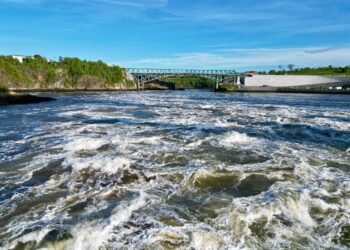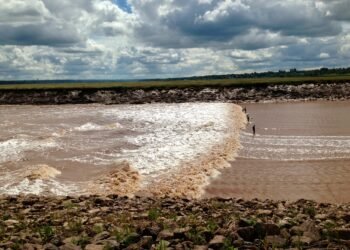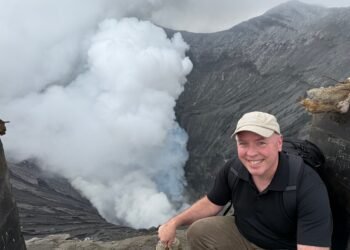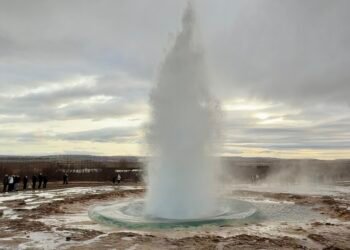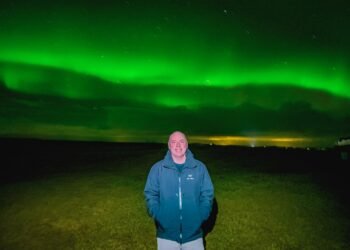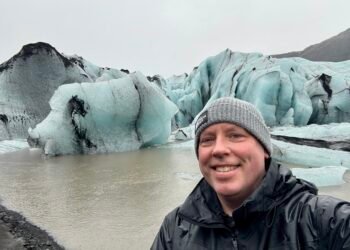In August, I set off to revisit a place I hadn’t seen in years—the mysterious Old Sow Whirlpool. Located between Deer Island, New Brunswick, and Eastport, Maine, this natural phenomenon is not only one of the world’s largest whirlpools but also a testament to the incredible tidal forces of the Bay of Fundy. With my drone in tow and a curious mind ready to explore, I documented this unforgettable experience from land and air. In this article, I blend my personal journey with the fascinating science and history behind the Old Sow.
My Journey to Deer Island
In the month of August, I decided to check out something I hadn’t seen in a very long time. The Old Sow Whirlpool, whispered to be one of the most powerful tidal whirlpools in the world, lies between Deer Island, New Brunswick and Eastport, Maine. With the roaring tides of the Bay of Fundy feeding it, I was eager to witness this awe-inspiring force of nature once more.
Armed with my DJI Mini 3 Pro drone, I envisioned capturing the whirlpool’s swirling energy from above, revealing patterns and currents invisible from the shore. There’s something thrilling about blending modern technology with age-old forces of nature.
The adventure began early in the morning. I left my hometown behind and made my way to the ferry terminal at Letete, where the Deer Island Princess II awaited. There’s no bridge connecting Deer Island to the mainland, so the only access is by boat. The 20-minute ferry ride across the Letete Passage was nothing short of breathtaking. The hum of the engine, the slap of waves against the hull, seabirds gliding on coastal winds, and the occasional seal or porpoise surfacing—it all set the tone for a day shaped by the ocean.

Upon arriving on Deer Island, I drove the quiet roads through forested paths and tiny fishing villages. The island is humble but rich in maritime culture. En route to Deer Island Point, I passed Fairhaven and crossed the 45th parallel—a fun geographical milestone marking the halfway point between the Equator and the North Pole.
Finally, I arrived at Deer Island Point, perched on the island’s southern tip. The landscape was dramatic: bold rocky shores, panoramic views of the Western Passage, and the rhythmic rumble of the tide charging past the island. It’s here that the Old Sow forms—roughly three hours before high tide—when the cool waters of the Bay of Fundy surge toward Passamaquoddy Bay.
Quick Facts about the Old Sow Whirlpool
Location: Between Deer Island, New Brunswick, and Eastport, Maine
Name: Old Sow, named for the sound it makes (like a grunting pig)
Size: Up to 76 metres (250 feet) in diameter under peak conditions
Formation: Caused by tidal currents from the Bay of Fundy
Best Viewing: 2–3 hours before high tide
Accessibility: View from Deer Island Point, especially near the Deer Island Point Light
Notable Feature: Often surrounded by smaller eddies or “piglets”
The Science Behind the Whirlpool
The Old Sow Whirlpool is more than a natural spectacle—it’s a physical expression of complex geophysical interactions. The Bay of Fundy has the highest tidal range in the world, with tidal differences reaching up to 16 metres (52 feet). Twice daily, this colossal volume of water is forced through narrow channels like the Western Passage.
Between the depths of Passamaquoddy Bay, the underwater ridges, and an array of sea mounts and trenches—some as deep as 122 metres (400 feet)—the incoming tide is disrupted, twisted, and compressed. The combination of bathymetry (the topography of the sea floor), tidal phase shifts between regions, and Coriolis effects caused by Earth’s rotation give birth to the Old Sow.
The result: swirling eddies, upwelling currents, and, at peak times, a large whirlpool surrounded by smaller ones, often referred to as “piglets.” These piglets form as friction and turbulence ripple outward from the main vortex.
Interestingly, the whirlpool is not a constant spectacle—it depends on tidal amplitude, moon phases (spring tides are best), and calm weather. Scientists, oceanographers, and curious minds alike continue to study the whirlpool as a living example of ocean dynamics.
While Old Sow holds the title as the largest whirlpool in the Western Hemisphere, it shares the global stage with other powerful maelstroms. Norway’s Saltstraumen, near the Arctic Circle, is the strongest known whirlpool, with water speeds reaching up to 37 km/h (23 mph). The nearby Moskstraumen, made famous in Edgar Allan Poe’s tale “A Descent into the Maelström,” forms off the coast of the Lofoten Islands and is one of the oldest known whirlpools. In Japan, the Naruto whirlpools are celebrated for their striking visibility and speed, forming as tides funnel through the narrow Naruto Strait. Each of these whirlpools, like Old Sow, reveals the immense forces that tides and underwater geography can unleash in our oceans.
The History of Old Sow
First documented by European settlers in the 18th century, the Old Sow has long been part of local lore. The name likely derives from the grunting or growling sound it can emit under extreme tidal conditions—evoking the image of a sow and her piglets.
Historically, mariners both feared and respected the whirlpool. Sailors had to time their crossings carefully to avoid the swirling waters, which could pull smaller boats off course. The phenomenon even appears in early navigational charts, marked as a navigational hazard.
Despite its power, the Old Sow is less dangerous than its more notorious cousins like Norway’s Saltstraumen or Japan’s Naruto whirlpools. It’s rarely a threat to larger boats and ships, and modern vessels pass by it safely. Yet, the legend persists, adding a mythic dimension to this fascinating site.
A Bird’s-Eye View
At Deer Island Point, I found a quiet spot near the Deer Island Light Beacon to launch my drone. The air was calm, visibility perfect. I watched the Atlantic surge past—its movement unmistakably swift and deliberate, as though the ocean itself had purpose.

As I scanned the water, I began to see the signs: circular eddies, surface disruptions, patches of upwelling. And then it came into focus—the Old Sow itself. It churned like a silent wheel, pulling the sea into its spiral, wide and majestic. From above, the sight was breathtaking: a graceful dance of blue and white, the ocean folding in on itself, as if turning the pages of a watery book.
With my drone hovering, I recorded footage in 4K, capturing not just the main vortex but also the surrounding piglets and the visible texture of tidal turbulence. The drone allowed me to observe it as a system, not just a spectacle—revealing interactions far beyond what I could see from shore.
Reflections by the Shore
After landing my drone, I took a moment to sit by the water’s edge. The cool breeze carried the scent of salt and seaweed. I watched the passage continue its powerful flow and let my thoughts drift. This place, this moment, was a vivid reminder of the forces that quietly rule our world.

The tides are driven by the gravitational pull of the Moon, amplified by Earth’s rotation and shaped by ocean basins. These forces, which we cannot see, create visible movements that shape ecosystems, guide migration patterns, and even impact our climate.
Sitting there, I thought of an old saying: Once saltwater gets in your blood, it never leaves. That day, it felt especially true.
Though I’ve spent many years away from the coast—living in cities like Fredericton, Toronto, and Ottawa—it’s always a powerful feeling to return to the salty breeze and the sound of the tide. My hometown isn’t far from Deer Island, and seeing these familiar sights again—the rugged shoreline, the roar of the ocean, the dance of currents through the Western Passage—brought a profound sense of homecoming. It reminded me that being a traveler isn’t just about movement. It’s about returning to the places that shaped you, finding wonder in them again, and feeling deeply connected to the rhythms of the Earth.
Practical Tips
Here are some practical tips I picked up during my visit to the Old Sow Whirlpool to help you make the most of your experience—from catching the ferry to Deer Island, to timing your arrival with the tides, and finding the perfect vantage point at Deer Island Point.
- Ferry: Take the free ferry from Letete to Deer Island. It runs frequently during the summer, but be sure to check the official schedule in advance—missing the last ferry could leave you stranded overnight, as accommodations on the island are limited.
- Timing: Aim to arrive 2–3 hours before high tide to catch the whirlpool in full motion.
- Navigation: Deer Island Point Park is well-marked and has easy parking access.
- Observation Point: The Deer Island Light Beacon area offers excellent views.
- Amenities: There are picnic spots and basic facilities at the park.
- Safety: Avoid walking on wet or jagged rocks. Keep a safe distance from the edge.
Pro Tips for the Science Traveler
If you’re eager to dive into the science behind tidal whirlpools and unlock even more from your visit to the Old Sow, these expert tips will deepen your understanding and enhance your experience at this fascinating coastal phenomenon.
- Tide Charts: Use tide tables from Saint John, NB or Eastport, ME for accurate timing.
- Tech Tools: A drone or polarized binoculars can enhance your observation. Bringing a drone allows you to study the whirlpool’s dynamics from above, offering a broader view of eddies and flow patterns. Be sure to follow all local drone regulations and fly responsibly.
- Geographic Bonus: Don’t miss the 45th Parallel sign on your way across the island.
- Weather Consideration: Clear, calm days offer the best aerial visibility.
- Ask Locals: Fishermen and park visitors often share helpful viewing tips.
- Learn More: Research the whirlpool’s connection to larger ocean circulation systems.
Other Bay of Fundy Wonders
Before you leave the Bay of Fundy region, be sure to explore other natural wonders shaped by its immense tides. In Saint John, New Brunswick, the Reversing Falls showcases the Saint John River flowing backwards as tidal currents overpower its flow—an incredible display of tidal force and geology. Further inland, in Moncton, you can witness the Tidal Bore, where a visible wave of muddy water surges upriver against the current, a daily reminder of the Bay’s reach. These phenomena, like the Old Sow Whirlpool, offer distinct windows into the science of tidal dynamics and the breathtaking interplay between land and sea.
Conclusion
The Old Sow Whirlpool isn’t just a destination—it’s an experience that stirs the imagination and anchors you in awe. Watching it swirl again after all these years, with better tools and a deeper curiosity, reminded me why I chase these hidden corners of science and wonder.
For the Science Traveler, the Old Sow is more than a curiosity. It’s a living, breathing lesson in fluid mechanics, a testament to the power of invisible forces, and an exploration on time, tide, and topography. If you find yourself on Canada’s east coast, take the journey. Let it pull you in.



